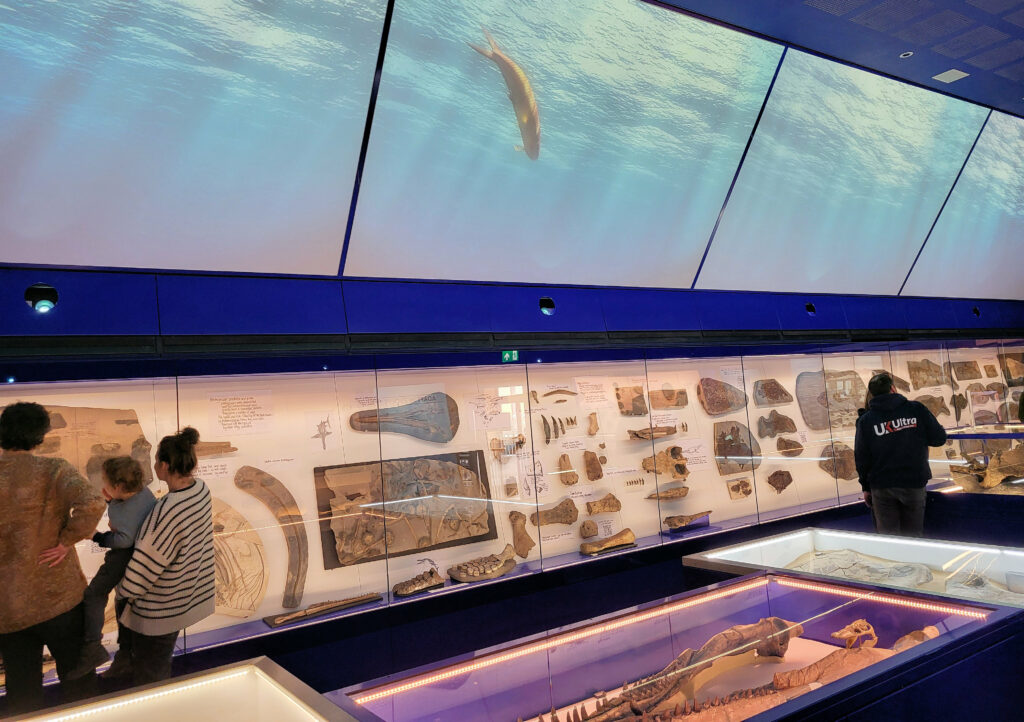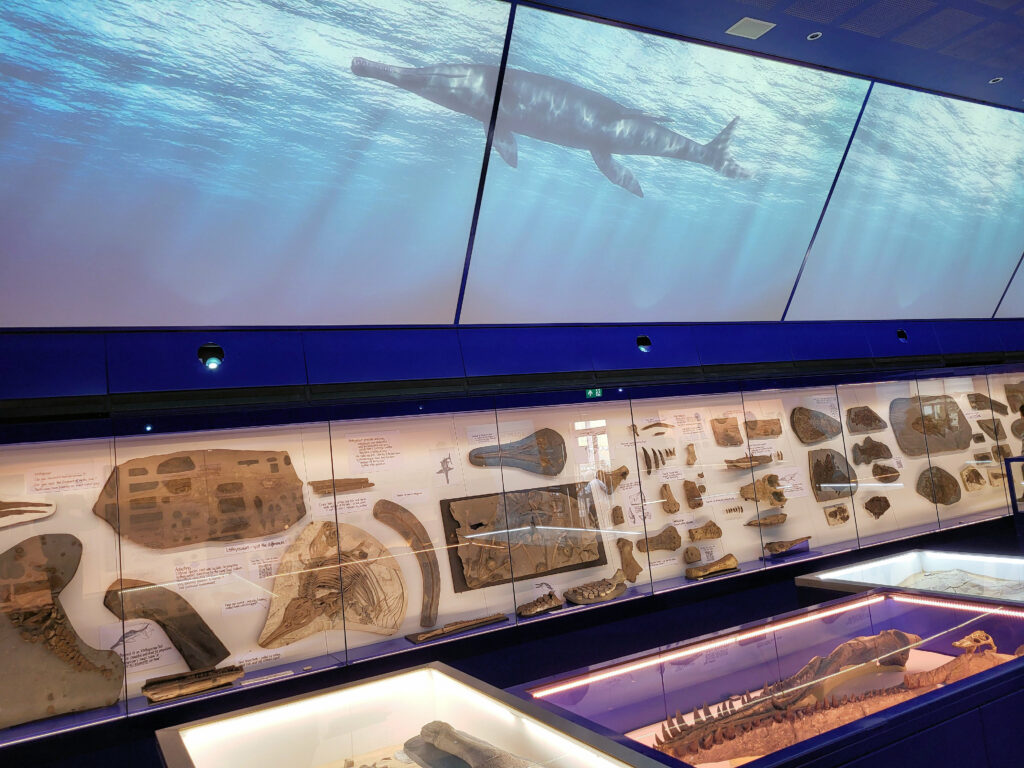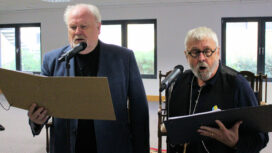After a five week shutdown for a £220,000 refit of its Jurassic era fossil displays, The Etches Collection at Kimmeridge in Dorset has reopened just in time for the Easter holidays.
However when the doors opened to the public on Monday 25th March 2024, there were queues waiting to see the new star exhibit, David Attenborough’s Sea Rex skull.

Part of the new look gallery with CGI screens showing Jurassic sea life
Pliosaur skull has pride of place
New cabinets in the main gallery allow the fossils – some of the rarest in the world – to be displayed under the best possible conditions and also allow museum staff to display more of their collection.
The exhibits have now been rearranged by species, with prehistoric ichthyosaurs, pliosaurs, fish, crocodiles, sharks, ammonites and rays grouped together.
And while the skull of the Sea Rex pliosaur made famous by the BBC documentary Attenborough and the Giant Sea Monster still holds pride of place at the centre of the exhibition, the display may soon need updating.
Fundraising towards a £150,000 target to dig the rest of the pliosaur skeleton from the cliff above the beach at Kimmeridge has recently passed £18,000 – but the need to start excavations has just got more pressing.

Etches Collection operations manager Carla Crook with ichthyosaurs in one of the new cabinets
“We have to get on the case quickly”
Operations manager at the Etches Collection, Carla Crook, said:
“We have been down to the location, the pliosaur is still in situ halfway down the cliff, but you can already see that parts of it have become exposed since we did the excavation with the BBC.
“Once the weather has dried up this spring, we will be looking to extract those exposed elements – bones of the vertebral column – and get them back to the museum.
“We will have to do it quickly, otherwise they will fall to the shore and get washed into the sea and be lost to us. We have to get on the case quickly to rescue those.
“It is looking like we will have to carry out the rescue a little bit at a time as it becomes exposed with the natural erosion of the cliff. They will be going down on the ropes to extract them, but because the parts are much smaller it will be an easier job.”

The skull of the fearsome Sea Rex is still centre of attention in the museum
An ichthyosaur named Britney
The Etches Collection is home to the finest single collection of fossils from the late Jurassic era, most notably sea monsters from the time when the Jurassic coast of Purbeck was a shallow tropical sea about 155 million years ago.
Nearly all of the fossils were found by museum curator Steve Etches in Kimmeridge Bay, in the local rocks.
A few have been generously donated by local fossil collector Philip Jacobs, who found the pliosaur snout which started the operation to extract the monster’s skull from the cliffs at Kimmeridge.
Philip Jacobs, of West Bexington near Abbotsbury, has also donated the museum’s ichthyosaur sea dragon, which has been nicknamed Britney.

A CGI ichthyosaur sails past skeletons in the new exhibition at Etches
“A very exciting time for us”
Museum curator Steve Etches said:
“This is a very exciting time for the museum. Not only do we have one of the most complete pliosaur skulls in the world on permanent display, but we also now have new state of the art cabinets which have given us more options for displaying the collection.
“The investment has given us a greatly enhanced humidity controlled environment for our precious specimens, significantly prolonging their display life.
“We are currently the only museum in the country to have such a technologically advanced setup, which we are very proud about.”

A collection of ammonites from the rocks of Kimmeridge Bay
“Project has been vital for the museum”
Carla Crook added:
“The great thing with these cabinets is that we can access them, move specimens around and add new fossils as they are discovered.
“Work has only just been completed – the last pieces went in yesterday, just in time for the opening – and we have been really busy since with people wanting to see the new displays as well as the Attenborough pliosaur.
“It gives us so much more flexibility and means that the specimens are being cared for under the best conditions.
“The project has been vital for the museum and has taken nearly 18 months of planning – we hope our visitors love the refurbished gallery as much as we do!”

A Jurassic Coast art exhibition by Dorset artist Caz Scott is also on display
20,000th visitor expected
The gallery refit was made possible by a £219,500 grant from the Wolfson Foundation and from the Department of Culture, Media and Sport’s museums and galleries improvement fund.
The museum’s 20,000th visitor of 2024 is expected to pass through the doors over the Easter holidays – 20,000 being the total annual visitor target for the Etches Collection before finding national fame through the David Attenborough show.
A new landscape art exhibition has also opened at the museum by Dorset artist Caz Scott, paying tribute to the geological features of the Jurassic coastline.

Unbelievably, the pliosaur whose body is still in the cliffs at Kimmeridge was just a juvenile when he died
Further information
- Help rescue the Sea Rex with donations at the museum’s Just Giving page





